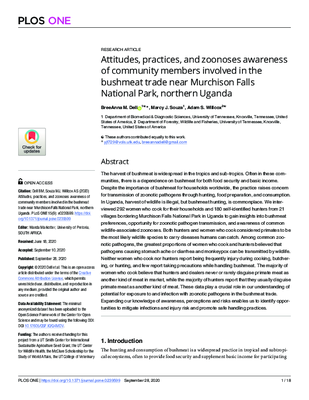Attitudes, practices, and zoonoses awareness of community members involved in the bushmeat trade near Murchison Falls National Park, northern Uganda
The harvest of bushmeat is widespread in the tropics and sub-tropics. Often in these communities, there is a dependence on bushmeat for both food security and basic income. Despite the importance of bushmeat for households worldwide, the practice raises concern for transmission of zoonotic pathogens through hunting, food preparation, and consumption. In Uganda, harvest of wildlife is illegal, but bushmeat hunting, is commonplace. We interviewed 292 women who cook for their households and 180 self-identified hunters from 21 villages bordering Murchison Falls National Park in Uganda to gain insights into bushmeat preferences, opportunity for zoonotic pathogen transmission, and awareness of common wildlife-associated zoonoses. Both hunters and women who cook considered primates to be the most likely wildlife species to carry diseases humans can catch. Among common zoonotic pathogens, the greatest proportions of women who cook and hunters believed that pathogens causing stomach ache or diarrhea and monkeypox can be transmitted by wildlife. Neither women who cook nor hunters report being frequently injury during cooking, butchering, or hunting, and few report taking precautions while handling bushmeat. The majority of women who cook believe that hunters and dealers never or rarely disguise primate meat as another kind of meat in market, while the majority of hunters report that they usually disguise primate meat as another kind of meat. These data play a crucial role in our understanding of potential for exposure to and infection with zoonotic pathogens in the bushmeat trade. Expanding our knowledge of awareness, perceptions and risks enables us to identify opportunities to mitigate infections and injury risk and promote safe handling practices.
https://biodiversitylinks.org/learning-evidence/wild-meat-collaborative-learning-group/evidence-collection/evidence-inbox/attitudes-practices-and-zoonoses-awareness_wild-meat.pdf/view
https://biodiversitylinks.org/learning-evidence/wild-meat-collaborative-learning-group/evidence-collection/evidence-inbox/attitudes-practices-and-zoonoses-awareness_wild-meat.pdf/@@download/image/image.png
File
Attitudes, practices, and zoonoses awareness of community members involved in the bushmeat trade near Murchison Falls National Park, northern Uganda
Author(s):
Dell, BreeAnna M
,
Souza, Marcy J
,
Willcox, Adam S
Publication Date: 2020
Location: Africa
DOWNLOAD FILE
The harvest of bushmeat is widespread in the tropics and sub-tropics. Often in these communities, there is a dependence on bushmeat for both food security and basic income. Despite the importance of bushmeat for households worldwide, the practice raises concern for transmission of zoonotic pathogens through hunting, food preparation, and consumption. In Uganda, harvest of wildlife is illegal, but bushmeat hunting, is commonplace. We interviewed 292 women who cook for their households and 180 self-identified hunters from 21 villages bordering Murchison Falls National Park in Uganda to gain insights into bushmeat preferences, opportunity for zoonotic pathogen transmission, and awareness of common wildlife-associated zoonoses. Both hunters and women who cook considered primates to be the most likely wildlife species to carry diseases humans can catch. Among common zoonotic pathogens, the greatest proportions of women who cook and hunters believed that pathogens causing stomach ache or diarrhea and monkeypox can be transmitted by wildlife. Neither women who cook nor hunters report being frequently injury during cooking, butchering, or hunting, and few report taking precautions while handling bushmeat. The majority of women who cook believe that hunters and dealers never or rarely disguise primate meat as another kind of meat in market, while the majority of hunters report that they usually disguise primate meat as another kind of meat. These data play a crucial role in our understanding of potential for exposure to and infection with zoonotic pathogens in the bushmeat trade. Expanding our knowledge of awareness, perceptions and risks enables us to identify opportunities to mitigate infections and injury risk and promote safe handling practices.


